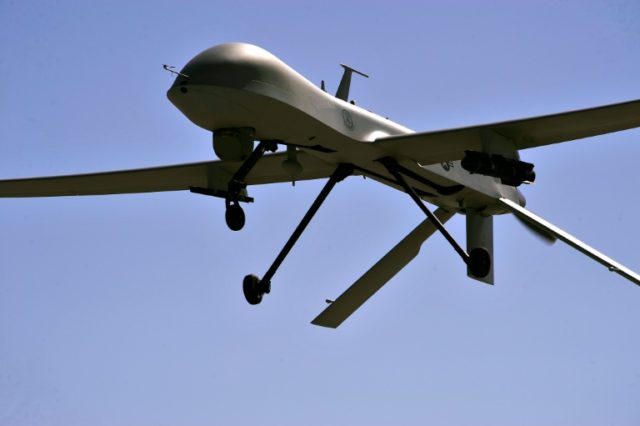Reports: First Drone Strikes Under Trump Kill Al-Qaeda Commander in Yemen

AFP
The first reported U.S. drone strikes under President Donald Trump have allegedly killed 10 jihadists from the thriving al-Qaeda branch in Yemen, including one of the terrorist groups’ field commanders.
According to The New York Times (NYT), “The United States did not take responsibility for the strikes, as is its standard policy. No other forces are known to be conducting drone strikes in the area.”
Citing Yemeni security and tribal officials who spoke on condition of anonymity, the Associated Press (AP) reveals that two U.S. drone strikes on Saturday took out al-Qaeda Yemen field commander Abu Anis al-Abi and two others.
Reporting from the Yemeni capital Sanaa, which has fallen under the control of Iran-allied Shiite Houthi rebels, NYT explains that the two airstrikes targeted the south-central Yemeni province of Bayda, killing “10 militants with Al Qaeda, three of them hit while riding on a motorcycle and the other seven killed in a vehicle in a separate drone attack in the same area.”
Overall, renewed fighting in Yemen reportedly killed an estimated 75 people on Saturday and Sunday, including the 10 jihadists killed in the suspected U.S. drone strikes.
The Times notes:
The greatest loss of life in Yemen over the weekend was from an offensive begun two weeks ago on the Red Sea coast by the Saudi-led coalition fighting on behalf of the [internationally recognized] government of President Abdu Rabbu Mansour Hadi… Airstrikes by the Saudi-led coalition killed at least 52 Houthi fighters in [the Red Sea port city of] Mokha on Saturday and Sunday, according to Yemeni news reports, while the Houthis killed 14 of the Hadi government attackers.”
NYT acknowledges that casualty reports by both sides — the Saudi-led coalition and the Iran-allied Shiite Houthis — vary widely, adding that “the true number of victims was impossible to verify, but it was clear that large numbers had been killed on both sides in the current offensive.”
The Saudi-led coalition in collaboration with forces loyal to the Yemeni president have reportedly seized back the port city Mokha, which the Times notes had been used to smuggle Iranian weapons destined for the Houthi rebels.
The Yemen-based al-Qaeda in the Arabian Peninsula (AQAP), considered one of the most dangerous branches of the terrorist group, has largely benefited from the security and political chaos in Yemen, seizing large swathes of territory and growing stronger than ever, as Shiite Houthis and armed groups loyal to the country’s former President Ali Abdullah Saleh, fight against the U.S.-backed Saudi-led coalition and Hadi forces.
The al-Qaeda branch has tightened its grip on the southern and southeastern parts of the Arab country.
AQAP capitalized on the Saudi-led coalition’s primary focus on the Iran-allied Houthis. Meanwhile, al-Qaeda’s rival the Islamic State (ISIS/ISIL) has also established a presence in Yemen.
In March 2015, deteriorating security conditions forced the U.S. to withdraw its military personnel out of Yemen as the Houthis, which controlled at least nine of the country’s 21 provinces at the time, stepped up their offensive.
The U.S. insisted that it had retained its capabilities to conduct counterterrorism operations in Yemen even after evacuating its troops out of the country and closing its embassy there in March 2015.
It was not until May 2016 that a small contingent of U.S. forces returned to Yemen and began targeting the resurgent al-Qaeda jihadists once again.
The use of drone strikes in Yemen, the world’s poorest country, dramatically increased under President Barack Obama’s watch, particularly in 2012 and 2016, according to data from the Britain-based Bureau of Investigative Journalism, which notes that “there were ten times more air strikes in the covert war on terror during President Barack Obama’s presidency than under his predecessor, George W. Bush.”
“A total of 563 strikes, largely by drones, targeted Pakistan, Somalia and Yemen during Obama’s two terms, compared to 57 strikes under Bush. Between 384 and 807 civilians were killed in those countries,” notes the bureau.
In its second public assessment issued in response to mounting pressure for more transparency about lethal U.S. operations overseas, Obama intelligence officials provided a much lower casualty count on Thursday, saying as many as 117 civilians had been killed in drone and other counter-terror attacks in Pakistan, Yemen, and elsewhere under the former president.
President Trump has vowed to toughen American efforts against terrorist groups.

No comments:
Post a Comment
Thanks for commenting. Your comments are needed for helping to improve the discussion.